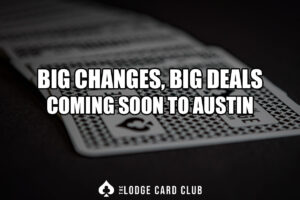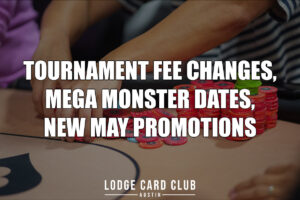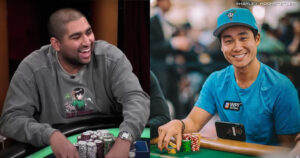The concept of bluffing is synonymous with the game of poker. The ability to pull of a successful bluff is crucial to a winning poker strategy.
A poker bluff happens when you bet with a hand, and an opponent folds a better hand.
Good players know that knowing when to bluff is the key to a solid bluffing strategy. When you’re sitting in a poker game at the Lodge, look to this article as a guide to the art of bluffing.
This guide will focus on bluffing in Texas Hold’em, the most popular poker game at the Lodge and at poker rooms around the world. Let’s begin:
Why Do I Need to Bluff in Poker?
Before we go into when you need to bluff, let’s discuss why you need to know how to bluff in poker. As Lodge co-owner and highly successful poker pro Doug Polk puts it:
“If you never bluff, poker won’t just be boring, it will be unbeatable — assuming your opponents are paying attention. They will be quick to exploit a playing style that depends too heavily on making strong hands, i.e., one that is not well-rounded with bluffing when appropriate.”
If your opponents know that you never bluff, they know that you always have a strong hand when you bet. They can then fold all but their very strong hands when facing a bet against you, and you’ll find it very tough to make any money.
Value betting in poker is the opposite of bluffing. When you value bet, you bet with the hope that your opponent calls with a worse hand.
For example, suppose you open in late position with:
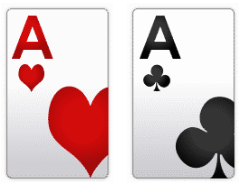
An opponent in the big blind calls.
The flop comes:
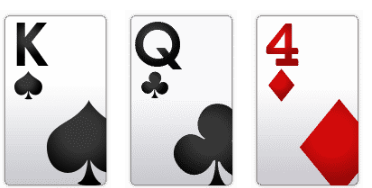
The BB checks, and you continuation bet. If your opponent knows that you never bluff, they can fold everything but their very best hands (and perhaps strong straight draws) right then and there.
Unless your opponent has top pair or something like jack-ten, you’re not making any money with your pocket aces.
If your opponent knows you’re a strong player that knows when and how to bluff, however, they’ll be compelled to call with many more hands beyond Kx and strong straight draws. The weaker Kx hands, Qx hands, middling pocket pairs, and even some ace-high hands in your opponent’s range might call against your c-bet range, which includes value bets and bluffs.
Let’s say your opponent calls your c-bet on that K♠Q♥4♦ board. The turn makes the board K♠Q♥4♦3♠.
An optimal poker strategy calls for a big bet here from you, and you should bomb it for more than the size of the pot. Your betting range should include strong value hands like AA, AK, QQ, 44, KQ and maybe a few other Kx hands.
You could also make that overbet with bluffs like JT, A5s, and hands that turned a spade flush draw. Drawing hands that you use as bluffs are known as semi-bluffs, and in many cases your bluffs on the flop and turn will include plenty of these semi-bluffs.
If your opponent knows you have bluffs in your turn betting range on the K♠Q♥4♦3♠, they’re forced into a very uncomfortable position with their Kx hands, Qx hands, and even their draws, which aren’t getting the right pot odds to call.
If your opponent knows you never bluff, however, you make their life very easy. They can simply fold anything that doesn’t beat your value range, and call (or raise) when they have a very strong hand.
When To Bluff In Poker
According to Polk, we should bluff more on earlier streets, and less on later streets.
The reasoning behind this guideline is simple. In terms of your equity against an opponent’s calling range, your bluffing range is at its strongest preflop, but that equity diminishes as the hand progresses.
For instance, a hand like 8♣7♣ is just eight-high before the flop. If you’re opening in late position, and the big blind calls, your eight-high hand is losing to a lot of your opponent’s calling hands. But 8♣7♣ does have at least 30-40 percent equity in most cases.
Let’s once again suppose that the flop comes K♠Q♥4♦. Your 8♣7♣ completely misses this flop, and you no longer have that 30-40 percent equity.
This flop does connect well with your overall BTN opening range though, and you might want to fire a continuation bet as a bluff and try to take this pot down right here.
If you do that, and your opponent calls, however, it might be time to shut down this bluff attempt on most turns.
A 6 or a 5 on the turn gives you a gutshot straight draw, but other than that no other turns really present prime bluffing opportunities. If an 8 or a 7 appears on the turn, giving you a pair, you’re likely better off checking the turn and hoping to get to a showdown with a hand that could still win the pot.
Remember, the purpose of a bluff is to get your opponent to fold a better hand. Even though 8♣7♣ is still a relatively weak hand on K♠Q♥4♦7♠, your pair of sevens in that spot could still be ahead of some hand that your opponent might call your flop c-bet with.
Betting a hand like this doesn’t accomplish much on the turn. Your opponent will probably fold weaker hands, and call with better hands. Your pair of sevens has some showdown value on the river if the hand gets that far, meaning it has a chance to win at showdown against your opponent’s hand without the need to bluff.
Bluffing With Drawing Hands On The Turn
Suppose, however, that in the same scenario you have a hand like:
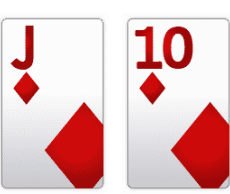
You open from the BTN preflop, get a call from the BB, and that same king-high flop:

As we’ve discussed, you can continuation bet on that flop often for a small bet size, maybe around 1/3-pot. That c-bet will shut down a lot of the BB’s missed hands right then and there.
If your opponent calls, you have a great candidate for a double-barrel bluff on almost all turns. You have an open-ended straight draw on the flop, but even if that doesn’t complete on the turn, you can still continue bluffing.
If an Ace or 9 hits the turn, you now have a straight, and your flop bluff has turned into a turn value bet. If you don’t see either of those straight-completing cards arrive on the turn, you can continue bluffing on the turn, and perhaps see your A or 9 hit on the river.
Also consider a turn like K♠Q♥4♦6♦; this card (or any diamond) gives you a flush draw on the turn in addition to the open-ended straight draw.
In general, if you arrive at the turn with a straight draw or a flush draw, that can present a great opportunity to continue barreling as a bluff.
As we’ve discussed in this article, bluffing is an essential part of the game in poker. If you’re the type of poker player that only bets with a good hand on a board like K♠Q♥4♦6♦, your opponent can easily fold all but their best hands.
Because of this, you’ll want to include some bluffs on this turn. Your strong value hands could include AA, AK, KK, QQ, KQ, KJ and 44. You’ll want to balance this value range with types of bluffs like JT, perhaps AJ and J9, and flush draw hands.
You need to include bluffs in your turn range, so why not pick hands that have equity and can turn into a strong hand on the river?
Bluffing With Blockers
In poker, blockers refer to a card that blocks your opponent from having a certain hand.
For instance, if your hole cards are:
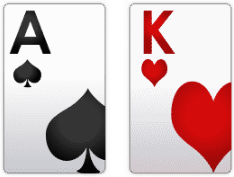
And the board is:

Your opponent can’t have the nut flush, as you have the A♠ in your hand. You can also remove all hand combos containing the K♠ or T♠ from your opponent’s range, as those two cards are on the board.
When you hold a blocker to the best poker hands in your opponent’s range, that can present a great opportunity to bluff.
Let’s say you’re on the BTN with A♠K♥. The HJ player opens, you 3-bet, an the HJ calls.
The flop comes Q♠T♠5♦, and HJ checks. This is a good spot for a continuation bet bluff, as you have two overcards, a gutshot straight draw, and blockers to some of your opponent’s strongest possible hands.
You’re holding A♠K♥, and the removal effects of that hand make it less likely that your opponent has AQ or KQ. You’re also completely blocking your opponent from having an ace-high flush draw, and you yourself have backdoor nut flush draw possibilities.
You c-bet the flop and your opponent calls. The turn hits the board, which now reads Q♠T♠5♦2♣. The overcards, straight draw, and blocker effects from the flop are still true on the turn, and this is a good spot to keep bluffing the turn.
Let’s say you bet the turn again, and your opponent calls. The river hits the board, which now reads Q♠T♠5♦2♣3♠.
Think about the hands you block with your A♠K♥. Your opponent can’t possibly have the ace-high flush. AQ and KQ are less likely. You also block A4, which makes a straight on the river.
The removal effects of your A♠K♥ make it a prime bluff candidate on this runout. As the preflop 3-bettor, you have many strong value hands that you would play the same way (AA, KK, QQ, TT, AQ, possibly A4 suited if you 3-bet that preflop).
If you only bet all three streets with value hands, and never bluff, your table image will be that of a player who always “has it.” Your opponents at the poker table won’t pay off your value bets if they catch onto this.
When Not To Bluff
Note that when the scenarios we’ve discussed in this article come up in a poker game, that doesn’t mean you pull the trigger on a three-barrel bluff every time.
There are certainly spots in poker where you do not bluff, or you bluff very selectively. Let’s consider some of those scenarios:
Don’t Bluff Often In Multiway Pots (Especially Out Of Position)
When more than two players are involved in a hand, the probability of someone having a strong hand goes way up.
If you’re in a hand with two or more opponents, and you’re out of position, keep the bluffs limited to high-equity draws.
For example, say you open UTG, the CO calls, the BTN calls, and the BB calls. You’re now involved in a four-way pot, which is quite a common occurrence if you play poker at the Lodge.
The flop comes Q♠T♠5♦. The BB checks, and the action is on you. You’re out of position on the CO and BTN, and the BB will often check when first to act in this scenario, meaning that player could have a strong hand.
You don’t want to bluff much in this setup at all. Keep your bluffs (if any) limited to very strong combo draws like A♠K♠, A♠J♠, and K♠J♠.
If you’re in position in a multiway pot, you can open up your bluffing range a bit more. For example, let’s say you’re the BTN player in this spot, and the action checks to you. You could add a few more bluffs to your range, but don’t get carried away.
It’s tough to get a bluff through against three players, and you’ll be doing just fine if you don’t attempt many bluffs at all in this scenario.
Don’t Bluff A Calling Station
The “don’t bluff a calling station” adage comes from legendary players like Doyle Brunson, who learned decades ago that bluffs simply don’t work against certain types of players.
Calling stations are players that just can’t find the fold button, and will call down with just about any kind of made hand postflop.
Let’s go back to one of the scenarios we looked at earlier. You’re on the BTN. The HJ player opens, you 3-bet, and the HJ calls.
The flop, turn, and river come out Q♠T♠5♦2♣3♠. You bet all three streets and your opponent calls all three bets. Your opponent shows 9♣9♦.
Whether you were bluffing or value betting as the BTN in this hand, the HJ has shown their true identity as a calling station.
This type of player doesn’t fold to bluffs. Adjust accordingly, and prepare to bet very thin for value.
Don’t Bluff When A Tight Player Has Called One Or More Big Bets
We’ve all played against the player type that folds everything except the absolute nuts. You can bluff players like this very aggressively, as they will fear that you always have the nuts.
When this player type hangs in a hand, however, beware.
Let’s go back to the previous scenario. You’re on the BTN. The HJ player opens, you 3-bet, and the HJ calls.
The flop, and turn, come out Q♠T♠5♦2♣. You bet both streets and your opponent reluctantly folds the turn, and shows A♣Q♦.
This is a player that only stays in a hand if they have the absolute nuts, or something close to it. If you’ve tagged a player as very tight, but all of a sudden they’re calling big bets in a hand, it might be time to shut down any bluff you’re thinking about.
Final Thoughts On Bluffing
Let’s go to another quote from Doug Polk as we finish up this piece on bluffing in poker.
“The most common mistake I see from players when it comes to bluffing is letting fear keep them from pulling the trigger,” Polk said.
If you want to become a strong poker player, you must add a solid fundamental bluffing strategy to your game. You won’t win your fair share of pots if you only bet for value.
Adjusting to the different player types at your table is key, however. Against tight players who crumble under betting pressure, you can ramp up the bluffs. Against calling stations, you can take the bluffs out of your range, and focus on value betting.
Check out Doug Polk’s article on bluffing from Upswing Poker:

